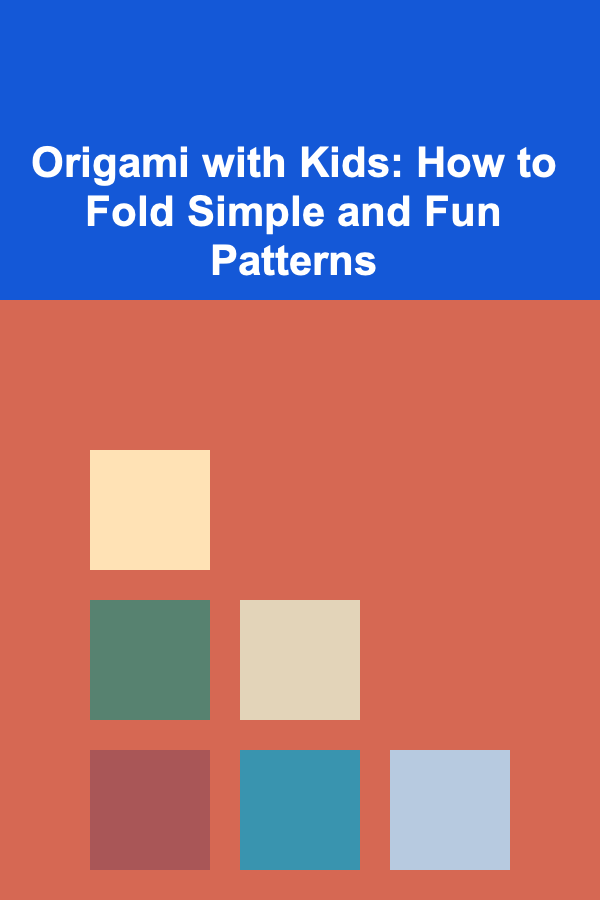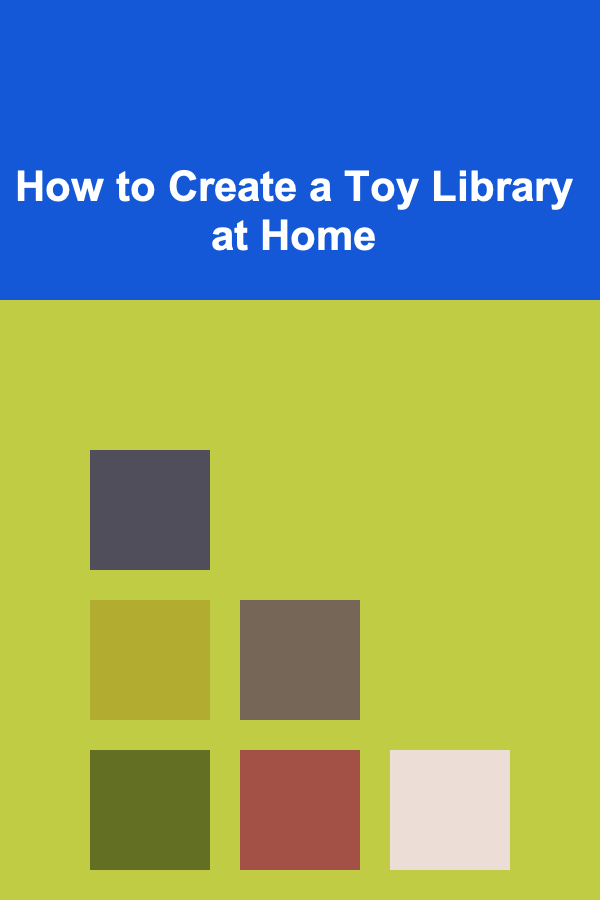
Origami with Kids: How to Fold Simple and Fun Patterns
ebook include PDF & Audio bundle (Micro Guide)
$12.99$6.99
Limited Time Offer! Order within the next:

Origami, the ancient Japanese art of paper folding, is a wonderful way to engage kids in a creative and educational activity. With just a square piece of paper and a little patience, children can create animals, flowers, geometric shapes, and more. Origami not only helps children develop fine motor skills, hand-eye coordination, and patience but also stimulates their imagination and critical thinking. Whether it's for a rainy afternoon at home or a classroom activity, origami offers endless fun and learning opportunities for children of all ages.
In this article, we will explore simple and fun origami patterns that kids can easily fold. These projects are designed for beginners, requiring minimal steps and materials, while still being rewarding. Let's dive into the world of origami and explore how to introduce kids to this delightful craft.
Why Origami is Great for Kids
Before diving into the folds and creases, let's explore why origami is such a beneficial activity for kids:
1. Enhances Fine Motor Skills
The process of folding paper requires precision, which helps children improve their dexterity and coordination. Each fold, crease, and turn challenges their ability to handle small details and develop their fine motor skills.
2. Boosts Creativity and Imagination
Origami is a fantastic way to stimulate creativity. As children begin to see the possibilities of what they can make with a simple sheet of paper, they get excited to try new designs. They might even invent their own creations.
3. Improves Focus and Concentration
Origami requires patience and concentration, which are excellent skills for children to develop. Following a sequence of steps to make a finished product helps kids learn to focus on tasks and see them through to completion.
4. Teaches Patience and Perseverance
Some origami projects can be challenging, and kids must learn to persevere through mistakes. When they finally complete a difficult model, they experience the satisfaction of accomplishment.
5. Encourages Logical Thinking
Origami is all about following steps in a logical order. This helps children develop problem-solving skills as they figure out how the folds lead to the final shape. Many patterns involve geometric concepts, which can also introduce kids to basic math principles.
Now, let's explore some easy and fun origami patterns that kids can fold with ease and enjoyment.
Simple and Fun Origami Patterns for Kids
1. Origami Crane
The origami crane is perhaps the most iconic origami pattern and a great starting project for kids. It's simple, yet the finished result is stunning. It also carries significant meaning in Japanese culture, symbolizing peace and good fortune.
Instructions:
- Start with a square piece of paper.
- Fold the paper in half diagonally, then unfold.
- Fold the paper in half diagonally in the opposite direction, then unfold.
- Fold the paper in half horizontally, then unfold.
- Fold the paper in half vertically, then unfold.
- Bring the top and bottom edges to meet at the center crease.
- Turn the paper over and repeat step 6 on the other side.
- Lift the top flap and open it up to form a square base.
- Fold the two side edges of the top layer to the center crease, then fold the bottom point up.
- Turn the paper over and repeat the previous two folds.
- Fold the two top flaps to the center, then fold the top triangle down.
- Pull apart the top two flaps to create the wings, and gently pull the bottom flaps to form the tail and head.
Tip: The crane can be made even more fun by decorating it with markers or colored pens after it's finished.
2. Origami Frog
An origami frog is another classic project that kids love to make. The best part is that you can make the frog "jump" by gently pressing down on its back. This pattern requires a bit of practice, but it's a fun challenge for older children.
Instructions:
- Start with a square piece of paper.
- Fold the paper in half diagonally, then unfold.
- Fold the paper in half diagonally in the other direction, then unfold.
- Fold the paper in half horizontally, then unfold.
- Fold the paper in half vertically, then unfold.
- Fold the top and bottom edges toward the center crease to create a kite shape.
- Fold the left and right edges toward the center to make a narrow diamond shape.
- Fold the bottom triangle up to form the frog's legs.
- Turn the paper over and repeat step 8 for the other side.
- Fold the sides of the triangle to the center crease to create the body.
- Fold the bottom corners up to form the frog's feet.
- Gently pull the sides of the paper apart to create the frog's body, and push the bottom to make it "hop."
Tip: To make the frog jump, press down on the body, then release it. It will spring back into the air!
3. Origami Butterfly
The origami butterfly is a simple yet elegant design that kids can easily create. It's an excellent project for beginners because it's made with just a few folds, but it still looks amazing when completed.
Instructions:
- Start with a square piece of paper.
- Fold the paper in half diagonally, then unfold.
- Fold the paper in half diagonally in the other direction, then unfold.
- Fold the paper in half horizontally, then unfold.
- Fold the paper in half vertically, then unfold.
- Fold the paper into a triangle shape by bringing the corners together.
- Fold the top flaps of the triangle downward to form the wings.
- Fold the bottom corner of the triangle up, and then fold it back down to create the butterfly's body.
- Turn the paper over and repeat for the other side.
- Adjust the wings by gently pulling them apart to create a butterfly shape.
Tip: Experiment with different colored papers to make a colorful butterfly.
4. Origami Boat
An origami boat is an easy and fun project that children can fold in minutes. It's a great introductory project for very young children and can even lead to a little playtime afterward as they pretend to sail their boats.
Instructions:
- Start with a square piece of paper.
- Fold the paper in half diagonally, then unfold.
- Fold the paper in half diagonally in the other direction, then unfold.
- Fold the paper in half horizontally, then unfold.
- Fold the paper in half vertically, then unfold.
- Fold the top and bottom edges to the center, creating a rectangle.
- Fold the top and bottom edges to the center again, then unfold.
- Pull the top and bottom edges apart to form a diamond shape.
- Fold the bottom flap up to form the boat's hull.
- Pull the paper apart gently to reveal the boat.
Tip: For added fun, create a fleet of boats in different colors and sizes, and race them across a table!
5. Origami Heart
An origami heart is a perfect project for special occasions such as Valentine's Day or to create a heartfelt gift. It's easy to fold and can be decorated or used in cards or as part of a scrapbook.
Instructions:
- Start with a square piece of paper.
- Fold the paper in half diagonally, then unfold.
- Fold the paper in half diagonally in the other direction, then unfold.
- Fold the paper in half horizontally, then unfold.
- Fold the top edges to the center to create a kite shape.
- Fold the bottom triangle up to form the point of the heart.
- Fold the top corners of the kite shape to the center to make the heart shape.
- Fold the bottom triangle down to create the bottom of the heart.
Tip: Use colorful or patterned paper to make your heart stand out.
Tips for Making Origami Fun for Kids
- Start Simple: Begin with easy patterns that don't require too many steps. As kids build confidence, introduce more complex designs.
- Use Colorful Paper: Bright, colorful paper makes the origami models more visually appealing and fun to make.
- Make It Interactive: Turn the origami creations into a game or challenge. For example, create a race with the origami boats or have a contest to see who can make the most origami animals.
- Teach Through Stories: Share stories related to the origami models. For example, the crane can be tied to the Japanese myth of folding 1,000 cranes to make a wish come true.
- Be Patient: Origami requires a lot of patience, so encourage kids to take their time and not rush through the steps.
Conclusion
Origami is an engaging and educational activity that brings a world of possibilities to kids with just a square sheet of paper. It combines art, creativity, and critical thinking in a fun and interactive way. Whether making cranes, frogs, butterflies, or boats, children learn valuable skills while having a great time. So grab some paper, start folding, and watch your children's creativity soar with every fold!
Reading More From Our Other Websites
- [Home Party Planning 101] How to Plan an Eco-Friendly Home Party That Still Looks Amazing
- [Home Budget 101] How to Use Cash-Back Programs to Save Money
- [Home Lighting 101] How to Use Lighting to Set the Mood for Different Occasions
- [Home Staging 101] How to Stage Your Bedroom to Create a Relaxing Atmosphere
- [Organization Tip 101] How to Ensure Long-Term Stability with Proper Foundation Crack Repair Techniques
- [Personal Investment 101] Monetizing Your Deep Learning Skills: Strategies for Success
- [Mindful Eating Tip 101] From Plate to Podcast: Curating Your Daily Mindful Eating Listening Routine
- [Organization Tip 101] How to Document the Provenance of Each Antique Item
- [Personal Financial Planning 101] How to Build a Financial Emergency Fund from Scratch
- [Organization Tip 101] How to Use Furniture Arrangements for Better Flow in Your Space

How to Clean and Maintain Hardwood Floors for Long-Lasting Shine
Read More
How to Create a Toy Library at Home
Read More
How to Implement a Color-Coding System for Supplies
Read More
Mastering the Role of Retail Sales Associate: Advanced Techniques for Driving Store Performance
Read More
Why You Should Create a System for Managing Donations
Read More
How to Determine Your Eligibility for the American Opportunity Tax Credit
Read MoreOther Products

How to Clean and Maintain Hardwood Floors for Long-Lasting Shine
Read More
How to Create a Toy Library at Home
Read More
How to Implement a Color-Coding System for Supplies
Read More
Mastering the Role of Retail Sales Associate: Advanced Techniques for Driving Store Performance
Read More
Why You Should Create a System for Managing Donations
Read More